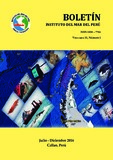Por favor, use este identificador para citar o enlazar este ítem:
https://hdl.handle.net/20.500.12958/3093| Título : | Estructura comunitaria del zooplancton en el estrecho de Bransfield durante el verano austral 2013 |
| Otros títulos : | Community structure of zooplankton in the Bransfield Strait during the austral summer 2013 |
| Autor : | Correa Acosta, Jonathan |
| Palabras clave : | Zooplancton;Placnton;Estrecho De Bransfield;Isla Elefante;Antártida |
| Fecha de publicación : | 2016 |
| Editorial : | Callao |
| Citación : | Bol Inst Mar Perú 31(2), 2016: p. 161-168 |
| Citación : | Boletín IMARPE;Vol. 31 n° 2, 2016 |
| Resumen : | Se presentan los resultados del análisis de muestras de zooplancton antártico
colectadas en el estrecho de Bransfield, febrero 2013. El volumen total del zooplancton fluctuó entre 3 y
305 mL/1000 m3. El zooplancton estuvo constituido por copépodos, eufáusidos, sifonóforos, gasterópodos,
apendicularias, quetognatos, anfípodos, pterópodos, ostrácodos, larvas de peces y otros. Copépodos,
eufáusidos y sifonóforos fueron más frecuentes, los copépodos representaron el 76% de la abundancia total y
fueron más diversos. Se determinaron 6 especies de larvas de peces, la más frecuente fue Notothenia kempi que
se distribuyó cerca de las islas Shetland del sur, bahía Almirantazgo y sureste de la isla Gibbs. El análisis de
comunidades estableció 3 grupos o conglomerados. El primer grupo fue el de mayor abundancia, dominando
Metridia gerlachei y Euphausia superba, distribuyéndose en masas de agua con temperaturas mayores a +1 °C.
El segundo grupo tuvo baja abundancia, se distribuyó en salinidades mayores a 34,2 ups y más cercanas a la
península Antártica. El tercer grupo tuvo abundancias intermedias, registró parámetros comunitarios más
altos y la mayor abundancia de Thysanoessa macrura; este grupo se distribuyó en salinidades menores a 34,1
ups y aguas de mezcla con temperaturas mayores a 0 °C. ABSTRACT: The results of the analysis of samples of Antarctic zooplankton collected in the Bransfield Strait in February 2013 are presented. The total volume of zooplankton ranged between 3 and 305 mL/1000m3. Zooplankton consisted of copepods, euphausiids, siphonophores, gastropods, apendicularians, chaetognaths, amphipods, pteropods, ostracods, fish larvae and others. Copepods, euphausiids and siphonophores were more frequent; but copepods accounted for 76 % of the total abundance and were more diverse. Six species of fish larvae were determined, the most frequent was Notothenia kempi which was distributed near the South Shetland Islands, Admiralty Bay and southeast of the island Gibbs. The analysis of communities established 3 groups or conglomerates. The first group was the most abundant dominating Metridia gerlachei and Euphausia superba, distributed in bodies of water with temperature greater than +1 °C. The second group had low abundance, was distributed in higher salinities to 34.2 ups and closer to the Antarctic Peninsula. The third group had intermediate abundances, recorded higher community parameters and the greater abundance of Thysanoessa macrura; this group was distributed in lower salinities to 34.1 ups and mixing water with temperatures above 0 °C. |
| Descripción : | Boletín IMARPE vol. 31, nº 2, 2016; p. 161-168 |
| URI : | https://hdl.handle.net/20.500.12958/3093 |
| Aparece en las colecciones: | Boletín 31(2), 2016 |
Ficheros en este ítem:
| Fichero | Descripción | Tamaño | Formato | |
|---|---|---|---|---|
| Boletin 31(2)-3.pdf | 4,36 MB | Adobe PDF |  Visualizar/Abrir |
Este ítem está sujeto a una licencia Creative Commons Licencia Creative Commons

